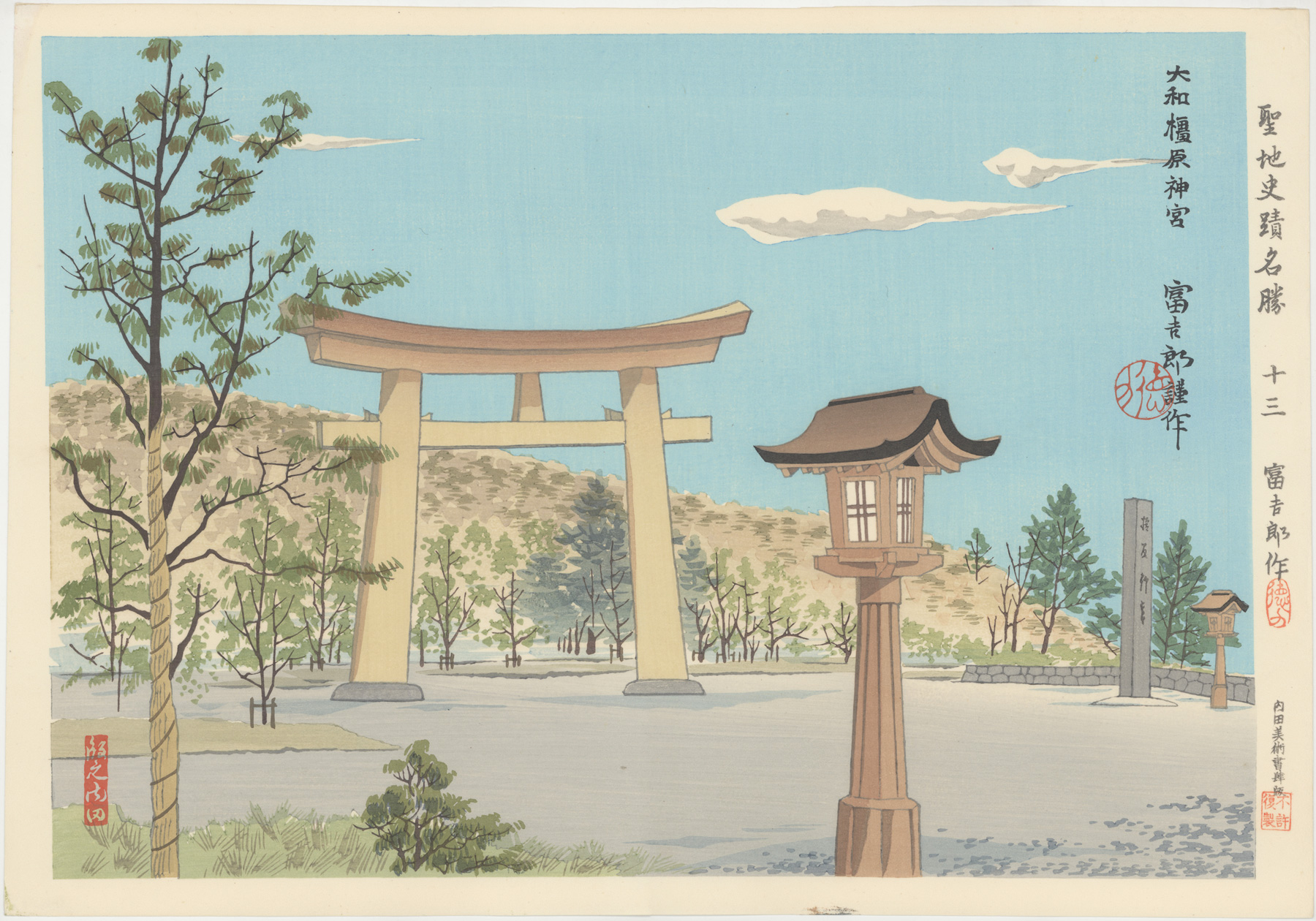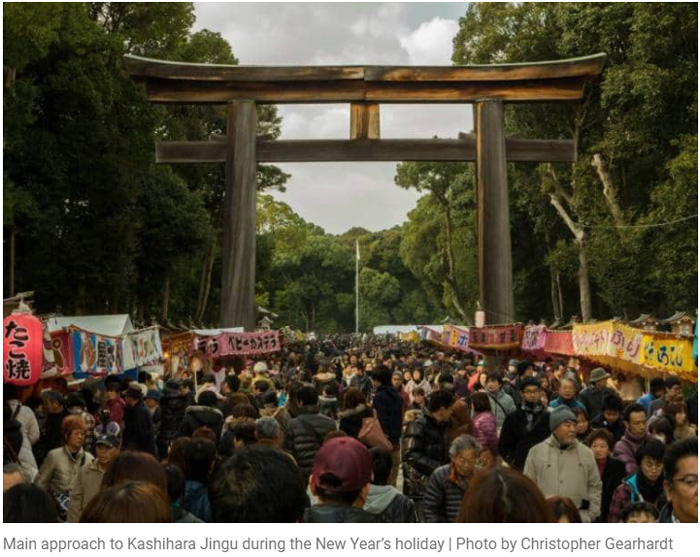About This Print
Print number thirteen in the fifty print series Scenes of Sacred and Historic Places (Seichi Shiseki Meisho) published by Uchida Woodblock Printing Company in 1941 depicting the large plaza in which sits the shrine's first gate (Kashihara jingū daiichi torii). The obelisk to the right is engraved with the shrine's name 橿原神宮.Kashihara jingū is a Shinto shrine located in the city of Kashihara, Nara Prefecture, Japan. The shrine's vast precincts cover an area of roughly 500,000 square meters. It was built in 1889 at the site of the Kashihara-gū where Japan's first emperor, Emperor Jimmu, is said to have acceded to the throne on February 11, 660 BC.
Kashihara Shrine and the Yamato Spirit
The use of the word Yamato 大和 in the print's title references the national foundation story embodied by Emperor Jimmu and the Kigen 2600 celebrations, starting in 1940, that marked the mythical 2,600th anniversary of Japan's founding. These celebrations which were years in the planning, were used to build popular support for Japan's territorial ambitions. More than 12,000 events were held to commemorate the anniversary1 including the publishing of this print series. Writing about the series the artist, Tokuriki, writes that his devotion to the sites is intended to demonstrate to the people the dignity of the national polity, going on to say that he advocates prints as a means of providing comfort and pleasure to the wholesome citizens of the nation.2
On the 1940 observance of the annual rites for Jimmu at the Kashihara Shrine, some 1,100,000 people visited the shrine, and a further eight million or more visited during the year.3
Even today the shrine draws huge crowds (see below photo) around the New Year's holiday, many of them right-wing nationalists who long for a return to state sponsored Shinto and militarism.
1 The People's Emperor: Democracy and the Japanese Monarchy, 1945-1995, Kenneth J. Ruoff, Harvard University Asia Center, 2001, p. 35.
2 “Out of the Dark Valley: Japanese Woodblock Prints and War, 1937-1945” by Kendall H. Brown, appearing in Impressions, The Journal of the Ukiyo-e Society of America, Inc., Number 23, 2001.
3 Shinto: A History, Helen Hardacre, Oxford University Press, 2017, p. 438.
The print artist Tokuriki and the publisher Unsōdō created two series of prints to mark Kigen 2600, or the 2600th year of Japan's mythical founding as a nation. The first, a paean to Mount Fuji, a sacred site of pilgrimage and worship, titled Thirty-Six Views of Mount Fuji, harkened back to Hokusai’s famous 1831 series of the same name. The second series, Scenes of Sacred and Historic Places, capitalized on the nationalist ideology that Japan was a divine land, presenting overtly nationalistic landscapes including shrines, temples, castles, places associated with the divine origins of Japan, Meiji era history and samurai
culture.
In his commentary on this series, the artist wrote that his devotion to these sites is intended to demonstrate to the people the dignity of the national polity, going on to say that he advocates prints as a means of providing comfort and pleasure to the wholesome citizens of the nation.
This series was extremely popular with domestic and foreign buyers who purchased one thousand copies within a short time after issuance.1 I imagine that foreign buyers were enchanted by the lovely scenes with much of the import of each print escaping them. In the 1950s, six prints from this series were re-printed under the title The Album of Famous Views of Japan and eight additional prints were re-printed under the title The Eight Views of Japan. Later printings omit the information in the margin and some position the artist's signature and print title within the image in a different location from the original issue.
For images of all the prints in the series, go to the website of Ross Walker's Ohmi Gallery at http://www.ohmigallery.com/Gallery/Tokuriki/SacredPlaces.htm.
1 Modern Japanese Woodblock Prints - The Early Years, Helen Merritt, University of Hawaii Press, 1998, p. 89.
In his commentary on this series, the artist wrote that his devotion to these sites is intended to demonstrate to the people the dignity of the national polity, going on to say that he advocates prints as a means of providing comfort and pleasure to the wholesome citizens of the nation.
For images of all the prints in the series, go to the website of Ross Walker's Ohmi Gallery at http://www.ohmigallery.com/Gallery/Tokuriki/SacredPlaces.htm.
1 Modern Japanese Woodblock Prints - The Early Years, Helen Merritt, University of Hawaii Press, 1998, p. 89.
Margin Annotations of Original Edition (top to bottom) and Print Title Within Image
 series title Seichi Shiseki Meisho 聖地 史蹟 名勝 |  十三 (19) |  Tomikichiro kin saku 富吉郎 謹作 (respectfully made by Tomikichiro) followed by oval seal1 |  内田美術書肆版 (Uchida Fine Art Shop) followed in seal form by Fukyo Fukusei (Reproduction forbidden)) | Print Title  大和橿原神宮 [Yamato, Kashihara Jingū] |
1 possibly a reproduction of an old censor's seal
The title of each print appears within the image area along with the artist's signature and seal. The artist's signature is comprised of the artist's name 富吉郎 (Tomikichirō) either by itself or followed by the single kanji character 作 (saku "made by") or by the character 謹 (kin "respectfully") followed by 作, as shown below.

| IHL Catalog | #1650 |
| Title | Kashihara Shrine, Yamato 大和橿原神宮 [Yamato, Kashihra Jingū] |
| Series | Scenes of Sacred and Historic Places (also seen translated as "Collected Prints of Sacred, Historic and Scenic Places") 聖地 史蹟 名勝 Seichi Shiseki Meisho |
| Artist | Tokuriki Tomikichirō (1902-2000) |
| Signature |  |
| Seal | 徳力 Tokuriki seal (see detail above) |
| Date | September 1941 |
| Edition | original (first) edition |
| Publisher | Uchida Bijutsu Shoten |
| Impression | excellent |
| Colors | excellent |
| Condition | excellent - minor mounting residue top corners verso from previous folio mounting |
| Genre | shin hanga (new print); fūkeiga |
| Miscellaneous | 十三 #13 in series |
| Format | horizontal ōban |
| H x W Paper | 11 5/16 x 16 3/8 in. (28.7 x 41.6 cm) |
| H x W Image | 10 7/16 x 15 1/16 (26.5 x 38.3 cm) |
| Collections This Print | Penn Libraries, Rare Book & Manuscript Library - Rare Book Collection Call no.: Portfolio NE1325.T65 A4 1940 |
| Reference Literature |



